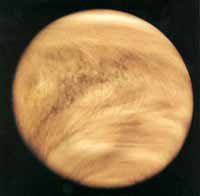About Venus
Overview
Venus’ celebrity is far from a recent phenomenon. Throughout history, numerous (at least 30) cultures have observed, been enthralled by and found their own name for Earth’s sister planet. Often depicted as a female (although in some Native American stories, it is a male character), Venus the planet and its atmosphere present an extremely hot and hostile environment. The planet’s sheer radiance may be a key to its sway on the imagination – Venus surface is completely shrouded in highly reflective clouds, making it the most brilliant object in the night sky other than the moon. Additionally, because its orbit is inside the Earth’s, Venus can be seen shortly after sunset and before sunrise at different times of the year. These appearances occur in an eight-year cycle, an observation the ancient Mayans of Central American used to construct a highly accurate Maya Calendar.
Venus’ brightness and periodic proximity to the Earth have also made it useful in some of history’s most significant astronomical advances. Venus has been in the sights of telescopes since the beginning, when Galileo discovered the planet’s moon-like phases. Galileo’s discovery was a milestone in the modern understanding of the Sun-centered (heliocentric) solar system. In addition, Venus has played a very crucial role in many modern advances in science. Early measurements of the speed of light were derived from observations of the transit of Venus across the solar disk. In the late 1960s, Venus was hit by the first radar signals to bounce off a solar system object. And in 1983 the former Soviet Union’s Venus orbiter, Venera 15 made the first radar observations of another planet from an orbiting platform.
Learn More
- Venus Fact Sheet
[ NASA ] - Galileo and the Discovery of the Phases of Venus (PDF)
[ Palmieri, P., (2001). JHA, xxxii, p.109 – 129 ] - Hubble images of Venus
[ HubbleSite ] - Your Travel Guide to Venus
[ BBC Science & Nature: Space ] - Venus Mythology
[ Wikipedia ] - Venus Crater Database
[ Lunar and Planetary Institute ]
Atmosphere of Venus
Of all the terrestrial planets, Venus has the thickest atmosphere and the slowest rotation rate.
One day on Venus is equal to 243.16 Earth days. This puts Venus in a class of its own, with Titan, the atmosphere-bearing moon of Saturn, as its only companion (rotation rate of about 16 days). Because Venus has no oceans to vary the surface heating, no tilt to its rotation axis, a nearly circular orbit around the Sun, no large scale topography, and a nearly uniform, global cloud cover, it seems its atmosphere would be easy to understand using only incoming solar radiation. Early models of the Venusian atmosphere suggested the winds should blow from the day side to the night side, and the day-night temperature difference could be large indeed.
Ground- and spacecraft-based observations tell us otherwise: the winds blow in essentially the same direction as the planet’s rotation (with a slight poleward component) at all observed latitudes and at all altitudes to about 100 km. It is only in the atmosphere above 100 km that the winds blow from the day-side to the night-side. Furthermore, the east winds and the poleward component generally increase with latitude to about 45 degrees. Poleward winds at this latitude in both the hemispheres and the east-west (zonal) and the north-south (meridional) winds decrease towards the pole. There is thus a peak in the angular speed of the atmosphere in two bands about mid-way between the equator of Venus and its poles – the equivalent of the terrestrial jet stream.
This global structure of the atmospheric motion organizes the Venus atmosphere in the form of two giant hemispheric vortices, one centered over each pole.







